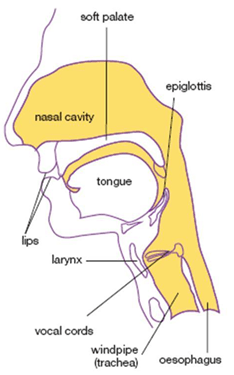Swallowing
 Before discussing dysphagia, I think it is important to briefly explain how normal swallowing takes place. It comes in three stages – the oral stage, the pharyngeal stage and the oesophageal stage. Each of these stages is controlled by different parts of the brain, different nerves and different muscles.
Before discussing dysphagia, I think it is important to briefly explain how normal swallowing takes place. It comes in three stages – the oral stage, the pharyngeal stage and the oesophageal stage. Each of these stages is controlled by different parts of the brain, different nerves and different muscles.
- In the oral stage, food is placed in the mouth and the lips close to keep food in the mouth. The food is then positioned by the tongue, moistened with saliva and chewed by the teeth. If the food is not moist enough, more saliva is produced. We consciously control this stage. Once the food is prepared in this way it is called a bolus. The bolus is now pushed to the back of the mouth by movements of the tongue and other muscles.
- During the pharyngeal (back of the throat) stage, we do not control what happens – it occurs automatically. Chewing, breathing and other functions temporarily stop, the epiglottis
 (which is a flap of tissue) flips down over the vocal cords (which close tightly) to stop food and drink going down the trachea (windpipe). It is a bit like a hinged trapdoor over a tunnel.
Muscular movements then guide the bolus towards the oesophagus.
(which is a flap of tissue) flips down over the vocal cords (which close tightly) to stop food and drink going down the trachea (windpipe). It is a bit like a hinged trapdoor over a tunnel.
Muscular movements then guide the bolus towards the oesophagus. - Swallowing now enters the oesophageal stage which is also involuntary. Muscles around the oesophagus contract and relax in sequence pushing the bolus down the oesophagus into the stomach. This is called peristalsis. It is a bit like squeezing sausage meat down a sausage skin where your hands represent rings of muscles which push the meat down the sausage skin, one hand below the other.
Most of us, thankfully, are able to complete this complex process without even thinking about it and we swallow successfully and safely. However, it only needs to have one tiny element go wrong e.g. part of the brain or a nerve or a muscle to malfunction and swallowing becomes a problem - DYSPHAGIA.